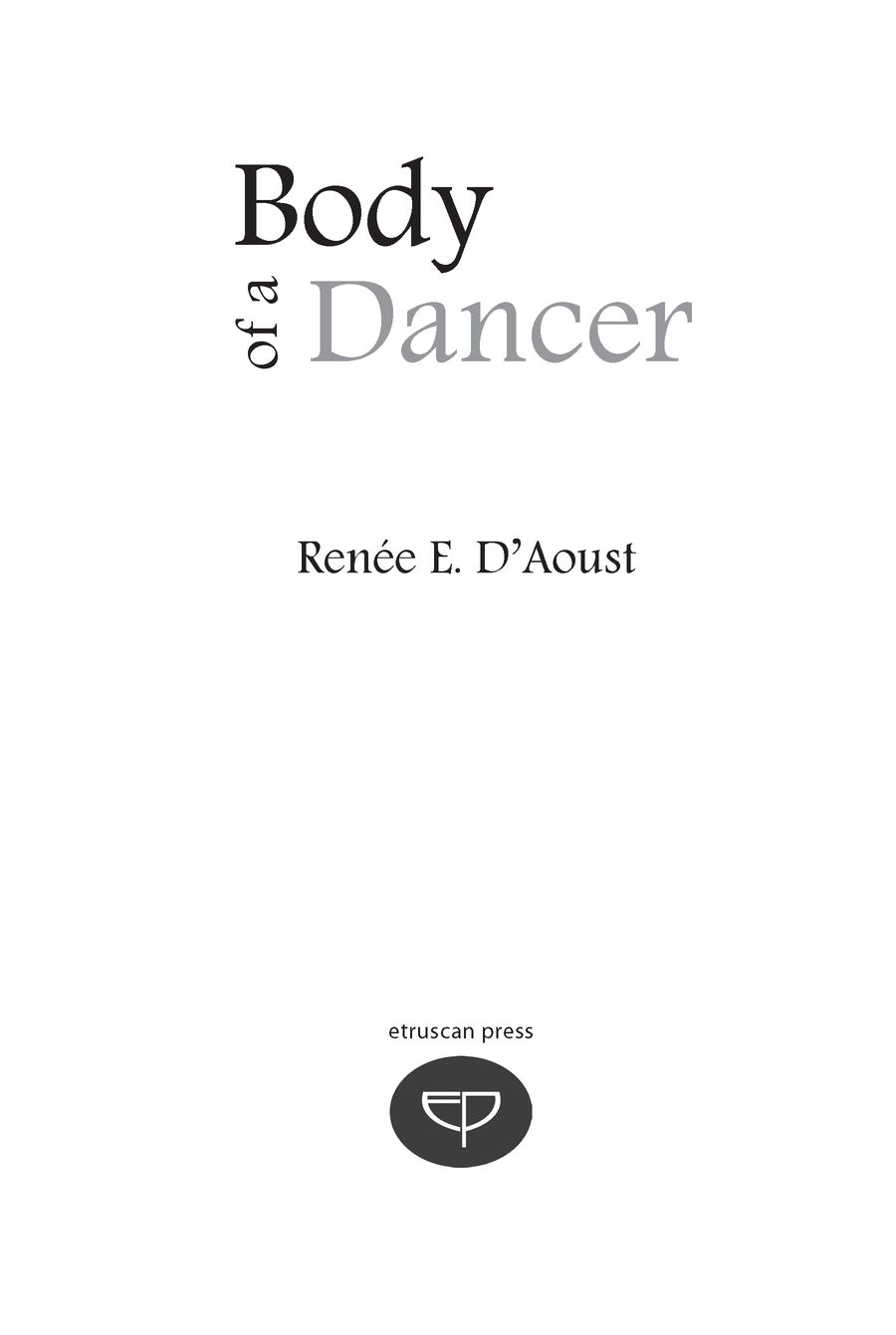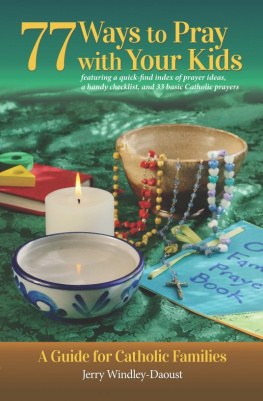Table of Contents
Acknowledgments
Grateful acknowledgment is made to the editors of the following books, contests, and journals in which some of these essays first appeared: Apollos Lyre, Island Rose; The Bend, Body of a Dancer; Black Canyon Quarterly, Attending a Wedding: NYC; Cadillac Cicatrix, Theatrical Release; Keyhole , Audition # 99 and Dancing in the Park; Mid-American Review, Graham Crackers, which was named a Notable Essay by Best American Essays 2006 and won the Associated Writers Programs Intro to Journals Project, Nonfiction Category; Notre Dame Review, Holy Feet, which was named a Notable Essay by Best American Essays 2010; Open Face Sandwich, Ballerina Blunders & a Few Male Danseurs, which was named a Notable Essay by Best American Essays 2009; Redwood Coast Review, Daniela Can Fly; and Under the Sun, Attending a Wedding: Paris. I am grateful to Robert Gottlieb for including Graham Crackers in the anthology Reading Dance, which he edited (Pantheon Books, 2008).
Several authors and publishers granted fair use permission for quotations used within this text, and I would particularly like to thank and acknowledge the following: Joan Brady and her memoir The Unmaking of a Dancer: An Unconventional Life; Peter Kurth and his book Isadora: A Sensational Life (Little, Brown & Company); and Robert Greskovic for his marvelous resource Ballet 101: A Complete Guide to Learning & Loving the Ballet. Thank you to Frederick T. Courtright, President of The Permissions Company, Inc., who generously provided needed advice.
Numerous colleagues, editors, and friends provided support and suggestions during all stages of writing this bookthank you, all, including: Lois Adams, Mindy Aloff, Lisa Anderson, Leilani Arthurs, Alexandra Asbury, Janet Asbury, Peter Awn and Columbia University School of General Studies, Michael Bassett and Sandra Kaufmann, Mary Batten, Kate Baxter, Stefanie Batten Bland, Robert Bland, Carolyn Boschi, Beth Caldwell, Kathleen Canavan, Diana Capriotti, Sandy Compton, Uttara Asha Coorlawala, Great Aunt Mary Cope, Debra Gail Courtney, Jo Dearsley, Tony DSouza, Lloyd Duman and Loralee Haarr and the North Idaho College English Department, Judy Ellis, Stacey Engels, Pat Engstrom, Paul Engstrom, Danna Ephland, Julie Evans, Lynn Garafola, Katie Glasner, Anna Hardwick, Andrea Harris, Maggie Herold, Coleen Hoover, Stephen Kessler, Michael Kimball, Robert Kiwala, Claudia La Rocco, Maria Mercurio, Karen Michel, Carol Moldaw, Georges Montillet, Dinty W. Moore, Peter Mugavero, Patricia N. Nanon, Andi and Lance Olsen, Kunle Owolabi, Barbara Palfy, Abigail Palkos brother, Wendy Perron, Gloria Ray and Suzanne Sawyer and the East Bonner County Library District, David Reuther, Rhonda Rubinson, Rhoda Sanford, Dr. Dorothy E. Saxton, J.D. Schraffenberger, Marian Sher-rett, the Sisters of the Holy Cross, John Sitter and Kate Raven, Janet Mansfield Soares and the Barnard College Department of Dance, Michael Steinberg, Truffle, the University of Notre Dame and the Notre Dame Creative Writing Program including MFA workshop members 2004-2006, the United States Postal Service including Cindy in Clark Fork and Junie in Hope, Rose and Bryan Wade, William Walsh, Thomas Warfield, Heidemarie Z. Weidner, Josh Weiss, Lili Yearsley Williams, Christopher Everett Wolf, Myra Woodruff, and Nancy Wozny. And to my teachers, with gratitude and affection, including: Mary Anthony, Wendy Arons, Dan Balaguy, Robert Battistini, W. Martin Bloomer, Susan Charlotte, Cornelius Eady, Austin Flint, Sonia Gernes, Sandra M. Gustafson, Flemming Halby, Alexis Hoff, Colette Inez, Ted McNeilsmith, Nol Mason, Marjorie Mussman, Nancy Rekow, Francia Russell, Valerie Sayers, Mark Slouka, J.T. Stewart, Steve To-masula, Dale Worsley, and Kevin Wynn. Robert A. Ferguson read an early draft of the manuscript and continues to provide valuable direction and support; I extend my heartfelt gratitude for his friendship and love of all things lovely, including trees.
I am indebted to Nicholas Sparks for providing the Nicholas Sparks Fellowship to complete my MFA at the University of Notre Dame under the tutelage of my advisor William ORourke, who brought me to Notre Dame and lent a gentle eye to my work. While I was at Columbia University, the School of General Studies, Charles Bernstein, and the Helena Rubinstein Foundation provided needed scholarship support (thank you Skip Bailey!). Thank you to the Montana Dance Arts Association for providing a scholarship to attend the Graham Center for Contemporary Dance and the Graham Center for subsequent scholarship support. In addition, I wish to thank the Idaho Commission on the Arts and the Puffin Foundation for grants that supported writing projects, which invariably led to this book. I extend my thanks to Suzanne Carbonneau and the National Endowment of the Arts for a 2008 fellowship at the NEA Journalism Institute for Dance Criticism at the American Dance Festival.
I am particularly grateful to everyone at Etruscan Press for their joy in writing and publishing and everything in between, including Phil Brady, for reading this book so generously, Jim Cihlar, Robert Lunday, Erin Miele, Marissa Phillips, Julianne Popovec, and, for her luminescent guidance, Starr Troup.
All parents of dancers deserve special praiseno other art is as ephemeral and needs witnesses and, as Mark Morris says, fabulous parents, as much as dance. Susan Saxton DAoust and Brian G. DAoust, my mother and father, drove me to daily ballet classes as a kid, bore witness to my New York modern dance life, and then watched me switch careers only to find themselves busy reading countless manuscript pages. You are loving and true. And every dancer should be so lucky to have big brothers: Anthony Frederick DAoust and Ian Lawrence DAoust have always applauded and continue to reflect my moral compass; thank you. Through walking, Daniele Puccinelli, my husband, taught me to waltz again. Truly, we are blessed.
Authors Note
With these recollections, I have taken some license with sequential time of dance events relating to my own personal history. In addition, I have changed a few names, identifying characteristics, and activities of some of the people to protect their privacy. The dance history of major figures and works contained herein should be considered factual. Any mistakes in that regard are my own.
Dedicated to Susan Saxton DAoust, my mother,
& Daniele Puccinelli, my husband,
with Gratitude & Love
Overture
Practice means to perform, in the face of all obstacles, some act of vision, of faith, of desire. Practice is a means of inviting the perfection desired.
Martha Graham
Body of a Dancer
Two years after Martha Graham died I stepped through the doors of Marthas House of Pelvic Truth in New York City. I didnt know it was called that then. All I knew was that I had to dance; training in the Graham techniquenot to mention receiving a scholarshipseemed like the most direct route. My intuition was correct, but I neglected to realize that the route I chose may also have been the most damaging. As my spine straightened, my heart became buried deeper inside my body and desire began to reverse, curling in and around, twisting a love of movement into dedicated self-loathing. Martha Graham was still very much alive inside those walls; her ghost took hold of my senses, making me contract and move my body in ways I had previously thought impossible.











